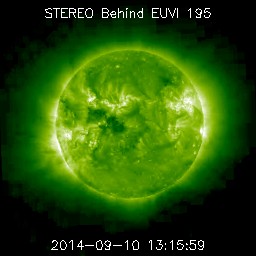.

What was the original design life of STEREO A and B? The STEREO mission components were designed to function for a two-year prime mission lifetime. We have exceeded the mission life by six years.
.
Since February 2011, the two spacecraft of NASA's STEREO mission have been providing scientists with unprecedented views of the far side of the sun. Placed in orbits that allow their perspective to change over the eight years since their launch in 2006, the satellites are about to enter a new phase of their journey: a time when the bright light and heat of the sun will stand in the way of sending data back to Earth.
This phase is a direct result of the orbits for STEREO, which is short for the Solar Terrestrial Relations Observatory.
"Both STEREO spacecraft orbit the sun like Earth does, but one is slightly inside Earth's orbit, the other slightly outside," said Joe Gurman, the project scientist for STEREO at NASA's Goddard Space Flight Center in Greenbelt, Md. "As a result, one circles the sun slightly faster than Earth, and one slightly slower."
These different speeds mean that over time, the satellites appear from Earth's perspective to drift farther apart, able to observe first the sides of, and eventually the entire far side of the sun. For the first time ever, thanks to STEREO and near-Earth solar telescopes such as NASA’s Solar Dynamics Observatory, humanity has had its first 360-degree view of the sun.
The orbits have continued to cause the STEREO spacecraft's position to change, however, and now they are nearing each other once again, this time on the far side of the sun. During this period when the sun blocks Earth's view -- a geometrical position known in astronomy as a superior conjunction -- radio receivers on Earth will not be able to distinguish STEREO's signal from the sun's radiation. Communication with the spacecraft will cease and the satellites will each go into safe mode without collecting data for a time. This will happen for STEREO-Ahead from March 24 to July 7, 2015. STEREO-Behind will be in superior conjunction from Jan. 22 to March 23, 2015. At least one spacecraft, therefore, will always be collecting data.
.

Graphic showing the approximate positions for the STEREO spacecrafts for July 2014.
.
Before and after this period occurs, the heating from the sun will also affect – though not shut down -- data collection. From wherever they are in space, the STEREO spacecraft aim their dish-shaped antennas toward Earth to send down data. This position puts the antenna fairly close to pointing at the sun, exposing the antenna electronics to more heat than they can safely bear. The antenna can be adjusted to point in slightly different directions, but the signal coming to Earth will be much fainter and won't allow for as much data to be down-linked. This antenna adjustment will begin on Aug. 20, 2014, for the STEREO-Ahead spacecraft and on Dec. 1, 2014, for STEREO-Behind.



During this phase, STEREO instruments will continue to run 24 hours a day, but they will gather lower resolution data than usual. A portion of this data will be down-linked whenever STEREO can link up with an Earth receiver. The rest of the data will be stored on board to be down-linked when the spacecraft reach a more auspicious geometrical position in early 2016.
"We might not know what's happening in real time," said Gurman. "But in early 2016, we will receive a message in a bottle. There will be a complete record of the radiation, the solar wind, and the magnetic field changes during any events on the sun. That kind of information helps us protect future NASA assets throughout the solar system."
To prepare for this off-pointing from the sun, STEREO-Ahead will undergo tests, during which time it will not be collecting data, from July 6-12, 2014. The same tests will be performed on STEREO-Behind from Sept. 29 – Oct. 6, 2014.
Throughout this entire phase until 2016, at least one STEREO spacecraft will be capturing data at any one time, so scientists will have an uninterrupted record of events on the far side of the sun to coordinate with the observations from solar telescopes on the Earth side.
.



Quelle: NASA
5042 Views
